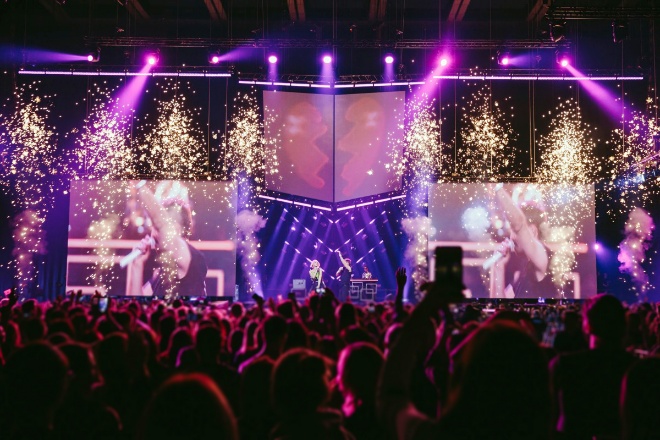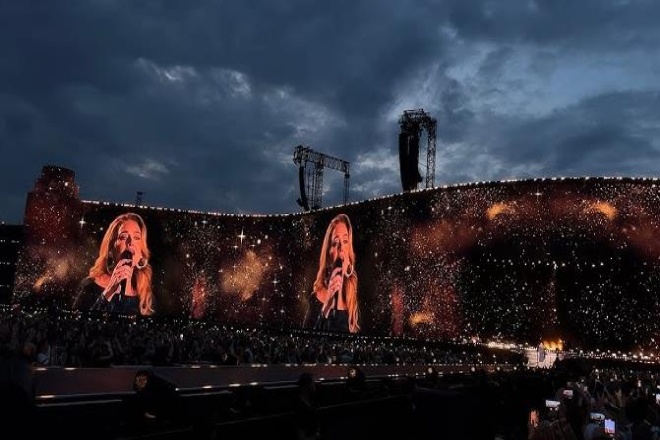Introduction

Nowadays, LED screens are used together with large spotlights in many activities. However, ensuring the clear visibility of LED screens under the strong illumination of spotlights has become an urgent problem that needs to be solved.
This article aims to explore various strategies such as technology, design, and maintenance to meet this challenge and ensure the best viewing experience for the audience.
Method 1: Improve the visibility of LED screens through technology upgrades
1). Brightness adjustment:
Under strong light sources such as spotlights, the brightness of LED screens becomes a key factor affecting visibility.
However, the emergence of automatic brightness adjustment technology has solved this problem well. It can monitor the ambient light intensity in real-time through built-in light sensing elements and dynamically adjust the brightness output of LEDs.
This means that when the spotlight is on, the LED screen can automatically increase the brightness to offset the influence of external light sources and ensure that the picture is still clear. This technology not only improves visibility but also effectively extends the service life of LEDs and reduces energy consumption.
2). Anti-reflective technology:
In order to reduce the reflection and glare caused by direct spotlights, LED screens use a variety of anti-reflective technologies. This includes applying a special anti-reflective coating on the screen surface, which can absorb or scatter part of the incident light and reduce the reflectivity.
In addition, the application of polarizers can effectively reduce the reflected light in a specific direction and improve the contrast of the picture.
More advanced optical structure designs, such as microlens array, can further optimize the propagation path of light, reduce the reflection phenomenon on the screen surface, and ensure that the audience can get a clear visual experience at any angle.
3). High dynamic range (HDR) technology
HDR technology significantly improves the visual effect of LED displays in complex lighting environments by enhancing color contrast and brightness range. Traditional display screens may appear dim or distorted under strong light sources.
HDR technology can present a wider brightness range, from deep black to bright white, and richer color levels. This allows the picture to maintain delicate and realistic color performance even under spotlights, enhancing the overall visual impact.
4). Viewing angle optimization:
In order to ensure that viewers at all angles can see the picture clearly, the viewing angle optimization of the LED display is crucial. Through carefully designed LED arrangement methods, such as using a denser pixel layout or a specific pixel arrangement pattern, the viewing angle deviation can be reduced, and the uniformity of the picture can be improved.
In addition, adjusting the screen curvature is also an effective means to improve the viewing angle range. According to the viewing distance and the layout of the venue, the curvature of the screen can be reasonably adjusted to make the light more evenly distributed to every corner, ensuring that every audience can enjoy a high-quality visual experience.
Method 2: Considerations when installing and laying out the LED display screen

When installing and laying out the LED display screen, there are many things to learn! Not only must the display effect be considered, but it must also be coordinated with the entire stage design so that the audience can watch it both enjoyable and comfortable. Next, let’s talk about these key considerations.
1). Position selection:
First, we have to find a good location for the LED display screen. Imagine if the display screen is directly illuminated by the spotlight, how dazzling the picture will be! Therefore, we must try to avoid placing the display screen directly under the spotlight and find a suitable installation angle.
In this way, we can reduce the interference of direct light and allow the audience to see a clear picture from all angles. We can try to tilt the display screen slightly or use other structures on the stage to block part of the light so that the effect will be better!
2). Shading design:
In addition to choosing a good location, we can also use some physical means to block light. For example, adding a sunshade or shading cloth to the LED display screen is like putting a hat or a scarf on it. In this way, the interference of direct light can be effectively reduced, making the picture clearer.
Of course, the shading design must also be consistent with the overall style of the stage and should not appear too abrupt. We can choose shading materials that are similar to the color of the stage background or use other elements on the stage to cleverly block the light.
3). Environmental coordination:
Finally, you have to consider the coordination between the LED display screen and the entire stage environment. After all, the display screen is only part of the stage. It must be matched with elements such as lighting, scenery, and color to present the best effect.
We can communicate with the lighting engineer to see how to arrange the lighting to highlight the effect of the display screen without conflicting with it.
At the same time, we can also choose a color combination that matches the theme of the stage so that the display screen and the entire stage are integrated, giving the audience a more shocking visual experience.
Method 3: Maintenance and calibration of LED display screens
As an important element in modern stages and various display activities, the display effect of LED display screens directly affects the audience’s visual experience.
Therefore, in addition to reasonable installation and layout, regular maintenance and calibration are also the keys to ensuring the long-lasting shine of LED display screens. Below, let’s talk about these tips for maintenance and calibration.
1). Regular cleaning:
Did you know? Dust and stains are the “invisible killers” of LED display screens. They not only block light and affect the clarity of the picture but may also damage the LED lamp beads and shorten the service life of the display screen.
Therefore, it is particularly important to clean the screen regularly. We can use a soft cloth and professional detergent to gently wipe the surface of the screen to remove stubborn dust and stains. In this way, the screen can remain clean and bright, allowing the audience to see a clearer picture.
2). Color calibration:
The accuracy of color and brightness is the key to the display effect of LED display screens. Over time, the performance of LED lamp beads may change, resulting in deviations in color and brightness.
At this time, we need to perform color calibration. With professional calibration equipment and technology, we can fine-tune the color and brightness of the display to ensure that each pixel can present the most accurate color. In this way, no matter how time passes, the display can maintain a consistent display effect, allowing the audience to enjoy a more realistic visual experience.
3). Fault monitoring:
LED display screens are composed of thousands of LED lamp beads, and individual fault points are inevitable. If they are not discovered and repaired in time, these fault points will spread like “infectious diseases” and affect the display effect of the entire display.
Therefore, it is particularly important to use intelligent monitoring systems. These systems can monitor the working status of the display in real-time, and once a fault point is found, an alarm will be issued immediately.
In this way, we can locate and repair the fault in time to avoid problems such as insufficient local brightness or color distortion. With the protection of the intelligent monitoring system, the LED display can work more stably and reliably.
4. Actual case analysis of LED display screens under the spotlight
In large-scale concerts, live sports events, and other occasions, LED display screens often need to maintain excellent display effects under the strong illumination of spotlights.
Next, we will share several actual cases that successfully coped with the spotlight challenge and analyze the specific technologies, design ideas, and implementation effects used in these cases.

Case 1: Adele Concert
At Adele’s concert, the LED display became the focus of the stage. Faced with the strong illumination of the spotlight, the display screen adopted high brightness adjustment technology and anti-reflective coating to ensure the clarity and color reproduction of the picture.
In addition, the concert also adopted HDR technology to enhance the color contrast and brightness range so that the picture still maintains a delicate and realistic effect under the spotlight. In terms of design ideas, the LED display screen is closely coordinated with the stage background, lighting, and other elements to create an immersive visual experience.
In terms of implementation effect, the audience said that the picture on the display screen is perfectly integrated with the stage performance, making people feel as if they are in a dreamlike world.

Case 2: Paris Olympic Games Live Broadcast
In the live broadcast of the Paris Olympic Games, the LED display screen also faced the challenge of spotlights. In order to deal with this problem, the display screen adopts an intelligent brightness adjustment system, which can automatically adjust the brightness according to the changes in ambient light.
At the same time, a special optical structure design is also adopted to reduce reflection and glare. In terms of design, the display screen is coordinated with the overall style of the venue, which not only highlights the excitement of the event but also maintains overall harmony and beauty.
In terms of implementation effect, the audience can clearly see every wonderful moment of the event through the display screen and feel the fighting spirit of the athletes.
Conclusion
In summary, through technological innovation, ingenious design, and meticulous maintenance, we can effectively improve the visibility of LED display screens under the spotlight.
With the continuous advancement of technology and the application of intelligent management, LED display screens will show more outstanding performance in the future and become a bridge connecting information and audiences.
Let us look forward to the LED display screens continuing to bloom their unique charm on the stage of light and shadow.
Finally, if you want to know more about LED display screens, please get in touch with us.
